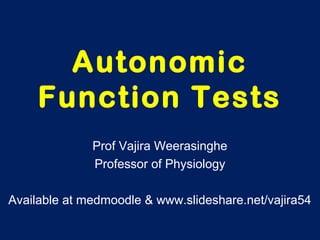
Autonomic function tests 2015
- 1. Autonomic Function Tests Prof Vajira Weerasinghe Professor of Physiology Available at medmoodle & www.slideshare.net/vajira54
- 2. Objectives Describe the physiological basis of the following autonomic function tests in relation to cardiovascular system 1. Heart rate variation during respiration 2. Heart rate variation during postural change 3. Valsalva manoeuvre (maneuver) 4. Cold pressor test
- 3. 1. Heart rate variation during respiration • The variation of heart rate with respiration is known as sinus arrhythmia • Inspiration increases the heart rate • Expiration decreases the heart rate • This is due to changes in vagal control of heart rate – by the influence of respiratory centre – by the influence of pulmonary stretch receptors
- 5. E:I ratio • Ask the subject to breath deeply at a rate of six breaths per minute for 3 cycles • Record maximum and minimum heart rate with each respiratory cycle
- 6. E:I ratio longest RR interval (expiration) Ratio = ------------------------------------- shortest RR interval (inspiration) E:I = 1.2
- 7. 2. Heart rate variation during postural change • Changing posture from supine to standing leads to an increase in heart rate immediately, usually by 10-20 beats per minute
- 9. Heart rate variation during postural change • On standing the heart rate increases until it reaches a maximum at about – 15th beat (shortest R-R interval after standing) – after which it slows down to a stable state at about – 30th beat (longest R-R interval after standing)
- 10. 30:15 ratio • The ratio of R-R intervals corresponding to the 30th and 15th heart beat 30:15 ratio RR interval at 30th beat • 30:15 ratio = ------------------------------ RR interval at 15th beat • This ratio is a measure of parasympathetic response Normal > 1.04 Borderline = 1.01-1.04 Abnormal =<1.00
- 11. 3. Valsalva Manoeuvre • Assesses integrity of the baroreceptor reflex • Measure of parasympathetic and sympathetic function • It is “forced expiration against a closed glottis”
- 12. Valsalva Manoeuvre • The Valsalva maneuver is performed by attempting to forcibly exhale while keeping the mouth and nose closed • It increases intrathoracic pressure to as much as 80 mmHg
- 13. Four Phases
- 14. – Transient increase in BP which lasts for a few seconds – HR does not change much – Mechanism: increased intrathoracic pressure and mechanical compression of great vessels due to the act of blowing Phase I – Onset of straining
- 15. Phase II - Phase of straining • Early part – drop in BP lasting for about 4 seconds • Latter part – BP returns to normal • Heart rate rises steadily
- 16. Mechanism • Early part – venous return decreases with compression of veins by increased intrathoracic pressure central venous pressure decreases BP decreases • Latter part – drop in BP in early part will stimulate baroreceptor reflex increased sympathetic activity increased peripheral resistance increased BP ( returns to normal ) • Heart rate increase steadily throughout this phase due to vagal withdrawal in early part & sympathetic activation in latter part
- 17. Phase III - Release of straining • Transient decrease in BP lasting for a few seconds • Little change in heart rate
- 18. Mechanism • Mechanical displacement of blood into pulmonary vascular bed, which was under increased intrathoracic pressure BP decreases
- 19. Phase IV – further release of strain • BP slowly increases and heart rate proportionally decreases • BP overshoots • Occurs 15-20 s after release of strain and lasts for about a minute or more
- 20. Mechanism • Due to increase in venous return, stroke volume and cardiac output
- 21. • With this high pressure there is no venous return since no venous blood can enter the thorax • The blood in the lungs and heart will be expelled at a higher pressure than normal
- 22. Phases ♦ Phase I Increase in BP ♦ Phase II Decrease in BP, Tachycardia ♦ Phase III Decrease in BP ♦ Phase IV Overshoot of BP, Bradycardia
- 23. Valsalva Ratio • Measure of the change of heart rate that takes place during a brief period of forced expiration against a closed glottis • Ratio of longest R-R interval during phase IV (within 20 beats of ending maneuver) to the shortest R-R interval during phase II • Average the ratio from 3 attempts
- 24. Valsalva Ratio Longest RR Valsalva Ratio = ----------------------------- Shortest RR ≥ 1.4 Values • more than 1.21 normal • less than 1.20 abnormal
- 25. Valsalva manoeuvre • Valsalva maneuver evaluates – 1. sympathetic adrenergic functions using the blood pressure responses – 2. cardiovagal (parasympathetic) functions using the heart rate responses
- 26. 4. Cold pressor test • Submerge the hand in ice cold water • This increases – systolic pressure by about 20 mmHg – diastolic pressure by 10 mmHg • Temperature and other environmental stressors are known to affect HR and BP • Sudden and increasingly painful cold stress causes massive discharge of the sympathetic nervous system and release of norepinephrine • This sympathetic discharge triggers arteriolar constriction, increased HR, and increased cardiac contractility • These responses combine to increase BP which is known as the cold pressor response • The test is used to evaluate cardiovascular autonomic functions
- 29. Valsalva manoeuvre in diabetic autonomic neuropathy
- 30. Other ANS tests in CVS • Head up tilt test (HUT) – Heart rate and BP response • BP Response to standing • BP Response to sustained handgrip • Plasma norepinephrine measured with the subject supine and after a period of standing provides another method of studying adrenergic function
